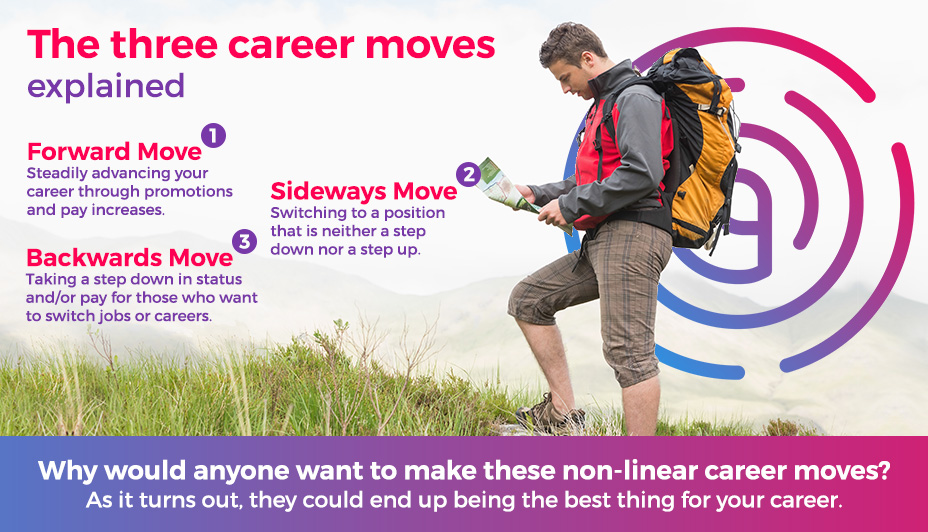- A career path is essentially a roadmap for your personal and professional development.
- Career paths don’t always follow a straight line.
- Your career path is not set in stone. You can change it at any point based on your needs and experiences.
It always comes out of nowhere. You’re doing something innocent—like getting coffee or walking the dog—and the unwanted thought suddenly pops into your head: Where the duck is my career going?
Totally weird that your brain has autocorrect…
Odd brain quirks aside, this particular thought isn’t an uncommon one to have, especially if you’re newly graduated, or you’ve been working the same dead-end job for the last few years. When your career seems to come to a complete standstill, it can be difficult to know what your next step should be.
Does this sound depressingly familiar? If so, it’s time to seriously consider mapping out your career path.
What Is a Career Path?
We all want to score a good-paying job in an industry that we love. But let’s face it, life isn’t some feel-good movie, and amazing career opportunities rarely just fall into people’s laps.

To achieve the career you want, you need to be strategic with the jobs you take. That’s where mapping out your career path can be a major help. Your career path is simply a series of jobs you take that ultimately lead you to your dream career. Career paths go hand-in-hand with a career plan, which is basically a list of short- and long-term goals that you strive for along your career path.
By mapping out a career path, you can…
- Avoid taking jobs that get you nowhere. Chances are good that you’ll have at least a few job changes over the course of your career. When you’re tempted to leave your current job for greener pastures, it helps to ask yourself one simple question: Will this progress my career in the direction that I want? If the answer is no, think twice before you jump ship.
- Identify gaps in knowledge and skills. Not sure what skills or training you need to progress to the next step in your career? Mapping your career path takes a lot of the guesswork out of the equation by helping you see which skills you need to reach your future career goals.
- Strive for something other than a paycheck. Sure, you want a job that pays the big bucks. Who doesn’t? But for many employees, a paycheck isn’t enough to keep them motivated at work. They want to be fulfilled in their careers, and that comes through personal and professional development.
- Bounce back quicker from career setbacks. Mapping out your career won’t make you immune to career setbacks. However, it can help you get back on track if your original career plans are derailed. Getting laid off unexpectedly can be super scary, but with a career strategy in place, you can pick up the pieces quickly and come back stronger than before.
Career Paths Are Not Set in Stone
If the idea of charting a career path for yourself makes you nervous, we totally get it. A lot of people feel like their future is set in stone once they make an official roadmap for it. Who knows what the future has in store, right?
But here’s the thing: Career paths can and do change, usually in our formative years. In fact, about one-third of students decide to change their major within three years of declaring it.
For others, the decision to change careers comes much later in life. This can lead to an interesting career path that resembles a winding road, which is completely normal. As you’ll see below, not all paths need to follow a straight line.

Make Your Move: 3 Powerful Career Moves You Should Know
Most of us want to move up in our careers. This is why organizations use phrases like “climbing the career ladder” and “vertical career mobility” to describe career advancement.
But did you know that working your way “up” isn’t the only direction your career path can go? You can also move sideways (aka, the “lateral” career move) and even backward.
Why would anyone want to make these non-linear career moves? As it turns out, they could end up being the best thing for your career. Here are the three career moves explained:
- Forward Career Move: The forward career move is what most people strive for in their careers. This move involves steadily advancing your career through promotions and pay increases. Example: Getting promoted from sales leader to vice president of sales.
- Sideways Career Move: This sideways or lateral career move can be a total game-changer for your career. This move involves switching to a position within your company that is neither a step down nor a step up. Employees may choose to move laterally in their careers in order to broaden their experience and become more successful in future positions. Example: Transitioning from the finance department to the sales department within the same company.
- Backward Career Move: A backward career move involves taking a step down in status and/or pay. While this might seem like career suicide, it makes perfect sense for those who want to switch careers or those who have been pigeonholed in their jobs. Who knows? If the perfect job opportunity comes your way, it could be worth it to start from scratch. Example: Leaving a job as an accountant to pursue a career opportunity as an editorial assistant.

Career Path Examples
You know that mapping your career path can be beneficial in the long term. You also know that you can move in several different directions to achieve your dream job. Now, let’s see this in action with a few career path examples.
Example #1: Education
Dream Job: Principal
Starting Point: Bachelor’s Degree in Teaching
- Milestone 1. Become certified as a teacher
- Milestone 2. Work for 3+ years while attending conferences and training seminars
- Milestone 3. Earn a master’s degree in teaching
- Milestone 4. Get promoted to assistant principal
- Milestone 5. Work for a few years before getting promoted to principal
Example #2: Technology
Dream Job: Software Development Manager
Starting Point: Finance Manager
- Milestone 1. Enroll in a coding bootcamp while working as a finance manager
- Milestone 2. Leave the current job to pursue a career in software development
- Milestone 3. Get a job as a junior software developer
- Milestone 4. Work for a few years before getting promoted to senior software developer
- Milestone 5. Get promoted to software development manager
Example #3: Entrepreneur
Dream Job: Business Owner
Starting Point: Salesperson
- Milestone 1. Start entry-level sales job
- Milestone 2. Get promoted to sales manager
- Milestone 3. Move sideways to take a position in the marketing department
- Milestone 4. Get promoted to senior marketing manager
- Milestone 5. Earn MA degree in marketing
- Milestone 6. Get promoted to vice president of marketing
- Milestone 7. Leave company to start your own marketing business
Example #4: Electrician
Dream Job: Master Electrician
Starting Point: High School Graduate
- Milestone 1. Enroll in technical college
- Milestone 2. Score an electrician apprenticeship and work for 4+ years
- Milestone 3. Apply for a journeyman electrician license
- Milestone 4. Gain experience as a journeyman electrician
- Milestone 5. Apply for a master electrician license
Example #5: Lawyer
Dream Job: Partner at a Law Firm
Starting Point: Bachelor’s Degree
- Milestone 1. Graduate from law school
- Milestone 2. Pass the bar exam
- Milestone 3. Work as a law associate at a firm
- Milestone 4. Work for six to nine years before making partner
How to Map Your Career Path from Scratch
Ready to take a stab at mapping your own career path? Here’s how to create an effective career path process that will put you on the fast track to success.

Step 1: Create a Detailed Career Map
The first step to mapping out your career is to create a career roadmap for yourself. Like the examples above, you should start from the top down with your dream job. Make a list of the sequential positions you’ll need to get there, keeping in mind that opportunities may arise where you can move sideways to expand your expertise.
Step 2. Fill in Position Profiles
After you’ve mapped out the job positions you need to reach your dream job, fill out the necessary skills, experience, training, and certifications you’ll need to achieve each step in your career. If you’re in a competitive field, you may want to consider listing a few additional skills that may increase your chances of advancing quickly.
For example, let’s say that you’re filling in a position profile for an assistant director of human resources. This is what it might look like:
Assistant Director of Human Resources
Minimum Qualifications:
- Bachelor’s degree in human resources, business, or a related field
- Three to five years of experience in human resources positions
- Proficiency with digital record-keeping and computerized communication
- Excellent analytical and interpersonal skills
- Strong leadership qualities
Desirable Qualifications:
- Master’s degree in Human Resources
- Experience with human resource information system (HRIS)
- SHRM certification
Step 3. Do Your Research
Once you have a career map, start doing in-depth research for different positions, with a heavy focus on your dream career. Carve out time each day to read news related to your industry and read blogs written by those in your field. To get a clearer picture of your dream job, try finding a job shadowing opportunity that will give you a behind-the-scenes look at your future career.
Step 4. Expand Your Knowledge and Skills
Now comes the tricky part: gaining the skills and knowledge you need to progress in your career. Read books, take online courses, and use whatever resources you have available to you at work to expand your skillset. Don’t forget to ask for performance reviews at work to see if there is anything that could stand to be improved.
If you want to speed the process up considerably, look into getting a mentor. A good mentor can be a huge asset to your career by teaching you valuable skills and being a source of support.
Step 5. Set Small Goals for Yourself
While big career goals may be admirable, they can be unrealistic or difficult to achieve. To keep yourself motivated and on track, be sure to set small, attainable goals that keep you moving toward your big goal. For instance, maybe your smaller goal is to learn Ruby programming in three months to help you reach your big goal of becoming a developer for a tech startup. Once you reach your milestone, continue setting small goals while keeping the bigger picture in mind.
Step 6. Network to Gain Visibility
Never stop networking! It’s seriously one of the single best things you can do for your career. Not only can networking broaden your job opportunities outside of your company, it can help you make a powerful lateral move to a different department. By networking with people outside of your department, you can learn about different positions within the company and get first-hand knowledge of what those positions entail. And if you make a good impression, you could give yourself a big advantage if/when you decide to apply for the position.

Preparing for a Brighter Future
You wouldn’t take a road trip without knowing where you were going, right? Mapping out your career path is like using your phone’s GPS for a trip. It tells you where you need to go in order to reach your final destination. Remember, it’s not set in stone! Be flexible with your career path and good things are sure to come your way.




